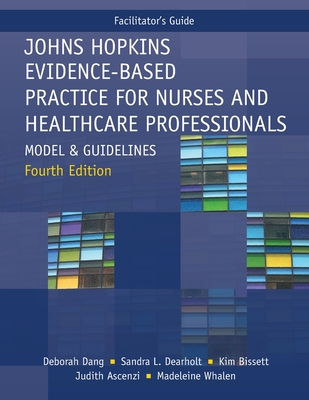
FACILITATOR GUIDE for Johns Hopkins Evidence-Based Practice for Nurses and Healthcare Professionals, Fourth Edition: Model and Guidelines
Description
The dynamic and competitive US healthcare environment requires healthcare professionals who are accountable to provide efficient and effective care. New evidence is continually surfacing in nursing and medical environments. Consumer pressure and increased patient expectations place an even greater emphasis on the need for healthcare professionals to deliver true evidence-based care in their daily practice.
Johns Hopkins Nursing is steadfastly dedicated to making it easy for frontline nurses, health professionals, and students to use best evidence in their everyday practice. With each edition, we revise based on the honest, frank, and generous feedback we receive from frontline users of the Johns Hopkins Evidence-Based Practice Model from across the globe. In this fourth edition, we are excited to be able to share these changes.
The 2021 revised JHEBP Model underscores the need for organizations to cultivate both a spirit of inquiry and an environment of learning that encourages questioning and seeking best evidence and its implementation and adoption in practice. Although our model was developed, tested, and implemented by and for nurses, we have had numerous requests and feedback from other health professionals to use the Hopkins model. Thus, we introduce the fourth edition with a new title-Johns Hopkins Evidence-Based Practice for Nurses and Healthcare Professionals. This change reflects the growing evidence base of the importance for interprofessional collaboration and teamwork, particularly when addressing complex care issues such as those often tackled by EBP teams. In this edition, our overarching aim is to provide practical and pragmatic explanations, approaches, and tools to guide and support teams engaging in EBP projects:
- We explicitly reflected the interprofessional nature of the EBP process and its use by all disciplines who serve, interact with, and care for those who seek services.
- We revised the flow of the book chapters across the sections to reflect the progression of steps in the EBP process.
- We included a new introduction for the evidence section that includes background on the use of evidence hierarchies, tips for differentiating research from quality improvement, and further explanation of the summary and synthesis steps in the evidence process.
- We made significant enhancements to the appendices by including flowcharts, decision supports, and greater specificity in the directions.
- We provided real-world examples for how to complete all tools using feedback from our global users as well as tried and tested helpful hints.
- We added a new chapter to expand and amplify strategies for dissemination that includes how to create a dissemination plan, audience-specific recommendations for internal and external dissemination venues, details of the pros and cons of different types of dissemination, guidance on submitting manuscripts for publication, and an overview of the journal review process.
- Chapter-specific enhancements:
- Chapter 3: Defines critical thinking and clinical reasoning and differentiates their use in the PET process.
- Chapter 4: Outlines stakeholder selection criteria and an algorithm to determine the need for an EBP project.
- Chapter 5: Includes new information on the literature screening process to navigate a large number of results Chapter 6: Provides useful clarifications of research approaches, designs, and methods with a focus on frontline staff as the target audience
- Chapter 8: Includes revised synthesis and translation steps; assesses risk prior to translation; prioritizes translation models accessible to frontline staff with a focus on the QI methodology and PDSA; and describes an expanded list of outcome measures to determine the success of an EPB project.

